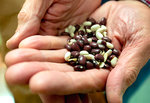Clear, 66° F
University of Wyoming crop physiologist Jim Heitholt is fairly unique in the agricultural world. He didn’t come from an ag family and didn’t consider agriculture as a vocation until …
This item is available in full to subscribers.
The Powell Tribune has expanded its online content. To continue reading, you will need to either log in to your subscriber account, or purchase a subscription.
If you are a current print subscriber, you can set up a free web account by clicking here.
If you already have a web account, but need to reset it, you can do so by clicking here.
If you would like to purchase a subscription click here.
Please log in to continue |
|



University of Wyoming crop physiologist Jim Heitholt is fairly unique in the agricultural world. He didn’t come from an ag family and didn’t consider agriculture as a vocation until finding himself fascinated with crop research during high school.
What he came to realize as he worked toward his doctorate, was he had an attribute common with his peers; a desire to help people.
“A lot of us got into this business because we were obsessed with finding ways to feed the world,” he said. “That’s why we got into studying crops and trying to find more efficient ways to produce food.”
He has spent his lifetime working to bolster farmer yields for regions in which he has worked and now finds himself supporting Big Horn Basin farmers’ crops for both edible and seed crops. He’s currently the director of the University of Wyoming’s Powell Research and Extension Center just north of Powell.
This harvest season the center is taking a more direct approach to hunger by donating a portion of its dried, edible beans and peas to area needy families.
The center will provide a portion of their products to the Food Bank of the Rockies in the Powell area. The colorful products will also be included in the next three Hughes-Pittinger American Legion Post 26’s commodities distributions, including Nov. 19, from 11 a.m.-1 p.m.
Post 26 Commander Russell Stafford said he is excited about the donation.
“It gives us another good source of protein for the food bank,” he said.
Commodities distributions serve an average of 150 families per month. The packages from the center will include preparation instructions and recipes with the packages. There will be several varieties available, including a mixture of pinto, great northern, black, and red beans. The post will also keep some of the product on hand for emergencies.
Dried beans, peas, garbanzo beans and lentils are known as pulse crops. Because they are healthy, nutritious and versatile, pulses are becoming a more popular choice for food manufacturers all over the world as ingredients in breads, noodles, snacks, and gluten-free foods.
The university center, located north of town on Road 9, has about 175 acres in irrigated crop production. The employees conduct studies and provide services to benefit Fremont, Hot Springs, Washakie, Big Horn, and Park counties — “and beyond,” the university proclaims.
Research focuses include weed control, irrigation, cropping systems, high tunnel production, variety performance testing, response to herbicide treatments and alternative crops. The center participates in numerous regional research and education projects.
Edible beans and peas are important crops in northwest Wyoming. Heitholt’s research is dominated by improving legume production to be disease and drought resistant in the irrigated ecosystem. After all the research is finished, the center has leftover product.
Typically, much of the research crops are used to supplement livestock feed. Each year, employees at the center will clean the ultra-small batches of harvested seed crops from each research plot for data collection purposes. Once the chaff and splits are removed, the harvest can be donated to the food bank.
“We’re hoping to contribute to help people’s lives. I feel like it’s our duty to do what we can,” Heitholt said.